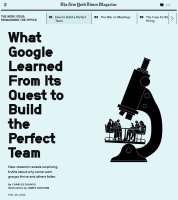
What Google Learned From Its Quest to Build the Perfect Team by Charles Duhigg

Read the summary below and get the key insights in just 10 minutes!

What makes some teams successes and others failures? Why can team dynamics be either energizing or draining? This article describes Google’s quest for a formula to optimize teamwork. Charles Duhigg, a Pulitzer Prize–winning reporter for The New York Times, explains Google’s findings on its analysis of group dynamics. getAbstract recommends these insights to managers looking for methods to motivate teams, create a constructive working environment and improve group productivity.
[/text_block]

- What Google discovered about building the perfect team,
- How you can implement and establish “psychological safety” in your workplace, and
- How Google now uses data to back up its formula for group success.

In a time of global commerce, teamwork is more important than ever before. In the last two decades, teamwork in businesses has increased by 50% or more, and interpersonal communication accounts for 75% of an employee’s day. Businesses can’t afford to underestimate the power of strong teams.
“When they gather, the group’s norms typically override individual proclivities and encourage deference to the team.”
Google’s “Project Artistotle” investigates why some teams work better than others. Its analysis shows that the combination of individuals making up the group is unimportant. Instead, a team’s “group norms” – its “traditions, behavioral standards and unwritten rules” – are essential to how well the group performs. Teams are successful if their group norms lead to equal speaking time for all individuals within the group and an awareness of others’ emotional states. These factors produce a situation in which members of the group feel comfortable, or “safe,” and therefore more willing to contribute. Google’s data show that what Harvard business professor Amy Edmondson called “psychological safety” within the group leads to an increase in the group’s collective IQ and therefore its effectiveness and productivity.
“Psychological safety…describes a team climate characterized by interpersonal trust and mutual respect in which people are comfortable being themselves.”
The next question for Google was how to encourage psychological safety within its teams. One manager responded to the findings with an experiment: He assembled his team and asked everyone to tell the others something personal. He himself shared that he was suffering from incurable cancer. Other team members shared their own stories, and when they moved to the business topics, people felt more at ease speaking openly about aspects of their work they would like to change. As a result of the meeting, the team manager promised to explain how the team’s work contributed to Google’s overall mission, and everyone agreed to pay more attention to how others were feeling. Breaking down the barrier between work and personal life that divides employees had helped the team nurture an environment of mutual trust and respect.
“In its race to build the perfect team, [Google] has perhaps unintentionally demonstrated the usefulness of imperfection.”
The most efficient meetings and the most professional employees may not produce the best results. Instead, allowing the “messy” and the “sad” can lead to an environment that is conducive to great results.
[/text_block]

Charles Duhigg is a Pulitzer Prize–winning reporter for The New York Times. He is the author of The Power of Habit and Smarter Faster Better, from which this article is adapted.
[/text_block]




